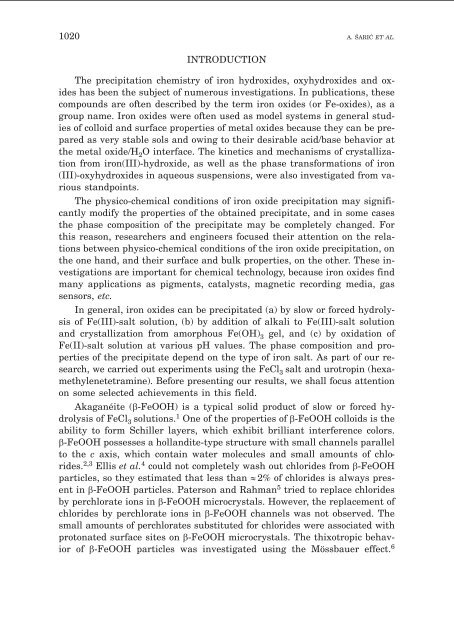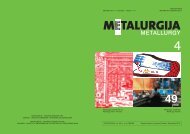Influence of Urotropin on the Precipitation of Iron Oxides from FeCl3 ...
Influence of Urotropin on the Precipitation of Iron Oxides from FeCl3 ...
Influence of Urotropin on the Precipitation of Iron Oxides from FeCl3 ...
Create successful ePaper yourself
Turn your PDF publications into a flip-book with our unique Google optimized e-Paper software.
1020 A. ŠARI] ET AL.<br />
INTRODUCTION<br />
The precipitati<strong>on</strong> chemistry <str<strong>on</strong>g>of</str<strong>on</strong>g> ir<strong>on</strong> hydroxides, oxyhydroxides and oxides<br />
has been <strong>the</strong> subject <str<strong>on</strong>g>of</str<strong>on</strong>g> numerous investigati<strong>on</strong>s. In publicati<strong>on</strong>s, <strong>the</strong>se<br />
compounds are <str<strong>on</strong>g>of</str<strong>on</strong>g>ten described by <strong>the</strong> term ir<strong>on</strong> oxides (or Fe-oxides), as a<br />
group name. Ir<strong>on</strong> oxides were <str<strong>on</strong>g>of</str<strong>on</strong>g>ten used as model systems in general studies<br />
<str<strong>on</strong>g>of</str<strong>on</strong>g> colloid and surface properties <str<strong>on</strong>g>of</str<strong>on</strong>g> metal oxides because <strong>the</strong>y can be prepared<br />
as very stable sols and owing to <strong>the</strong>ir desirable acid/base behavior at<br />
<strong>the</strong> metal oxide/H2O interface. The kinetics and mechanisms <str<strong>on</strong>g>of</str<strong>on</strong>g> crystallizati<strong>on</strong><br />
<strong>from</strong> ir<strong>on</strong>(III)-hydroxide, as well as <strong>the</strong> phase transformati<strong>on</strong>s <str<strong>on</strong>g>of</str<strong>on</strong>g> ir<strong>on</strong><br />
(III)-oxyhydroxides in aqueous suspensi<strong>on</strong>s, were also investigated <strong>from</strong> various<br />
standpoints.<br />
The physico-chemical c<strong>on</strong>diti<strong>on</strong>s <str<strong>on</strong>g>of</str<strong>on</strong>g> ir<strong>on</strong> oxide precipitati<strong>on</strong> may significantly<br />
modify <strong>the</strong> properties <str<strong>on</strong>g>of</str<strong>on</strong>g> <strong>the</strong> obtained precipitate, and in some cases<br />
<strong>the</strong> phase compositi<strong>on</strong> <str<strong>on</strong>g>of</str<strong>on</strong>g> <strong>the</strong> precipitate may be completely changed. For<br />
this reas<strong>on</strong>, researchers and engineers focused <strong>the</strong>ir attenti<strong>on</strong> <strong>on</strong> <strong>the</strong> relati<strong>on</strong>s<br />
between physico-chemical c<strong>on</strong>diti<strong>on</strong>s <str<strong>on</strong>g>of</str<strong>on</strong>g> <strong>the</strong> ir<strong>on</strong> oxide precipitati<strong>on</strong>, <strong>on</strong><br />
<strong>the</strong> <strong>on</strong>e hand, and <strong>the</strong>ir surface and bulk properties, <strong>on</strong> <strong>the</strong> o<strong>the</strong>r. These investigati<strong>on</strong>s<br />
are important for chemical technology, because ir<strong>on</strong> oxides find<br />
many applicati<strong>on</strong>s as pigments, catalysts, magnetic recording media, gas<br />
sensors, etc.<br />
In general, ir<strong>on</strong> oxides can be precipitated (a) by slow or forced hydrolysis<br />
<str<strong>on</strong>g>of</str<strong>on</strong>g> Fe(III)-salt soluti<strong>on</strong>, (b) by additi<strong>on</strong> <str<strong>on</strong>g>of</str<strong>on</strong>g> alkali to Fe(III)-salt soluti<strong>on</strong><br />
and crystallizati<strong>on</strong> <strong>from</strong> amorphous Fe(OH) 3 gel, and (c) by oxidati<strong>on</strong> <str<strong>on</strong>g>of</str<strong>on</strong>g><br />
Fe(II)-salt soluti<strong>on</strong> at various pH values. The phase compositi<strong>on</strong> and properties<br />
<str<strong>on</strong>g>of</str<strong>on</strong>g> <strong>the</strong> precipitate depend <strong>on</strong> <strong>the</strong> type <str<strong>on</strong>g>of</str<strong>on</strong>g> ir<strong>on</strong> salt. As part <str<strong>on</strong>g>of</str<strong>on</strong>g> our research,<br />
we carried out experiments using <strong>the</strong> <strong>FeCl3</strong> salt and urotropin (hexamethylenetetramine).<br />
Before presenting our results, we shall focus attenti<strong>on</strong><br />
<strong>on</strong> some selected achievements in this field.<br />
Akaganéite (-FeOOH) is a typical solid product <str<strong>on</strong>g>of</str<strong>on</strong>g> slow or forced hydrolysis<br />
<str<strong>on</strong>g>of</str<strong>on</strong>g> <strong>FeCl3</strong> soluti<strong>on</strong>s. 1 One <str<strong>on</strong>g>of</str<strong>on</strong>g> <strong>the</strong> properties <str<strong>on</strong>g>of</str<strong>on</strong>g> -FeOOH colloids is <strong>the</strong><br />
ability to form Schiller layers, which exhibit brilliant interference colors.<br />
-FeOOH possesses a hollandite-type structure with small channels parallel<br />
to <strong>the</strong> c axis, which c<strong>on</strong>tain water molecules and small amounts <str<strong>on</strong>g>of</str<strong>on</strong>g> chlorides.<br />
2,3 Ellis et al. 4 could not completely wash out chlorides <strong>from</strong> -FeOOH<br />
particles, so <strong>the</strong>y estimated that less than 2% <str<strong>on</strong>g>of</str<strong>on</strong>g> chlorides is always present<br />
in -FeOOH particles. Paters<strong>on</strong> and Rahman5 tried to replace chlorides<br />
by perchlorate i<strong>on</strong>s in -FeOOH microcrystals. However, <strong>the</strong> replacement <str<strong>on</strong>g>of</str<strong>on</strong>g><br />
chlorides by perchlorate i<strong>on</strong>s in -FeOOH channels was not observed. The<br />
small amounts <str<strong>on</strong>g>of</str<strong>on</strong>g> perchlorates substituted for chlorides were associated with<br />
prot<strong>on</strong>ated surface sites <strong>on</strong> -FeOOH microcrystals. The thixotropic behavior<br />
<str<strong>on</strong>g>of</str<strong>on</strong>g> -FeOOH particles was investigated using <strong>the</strong> Mössbauer effect. 6
















